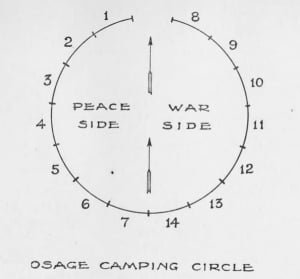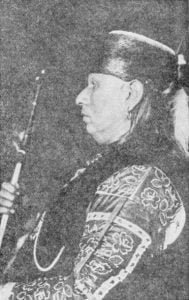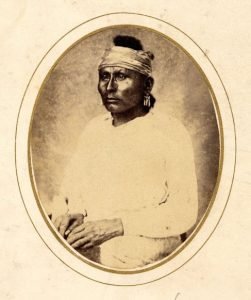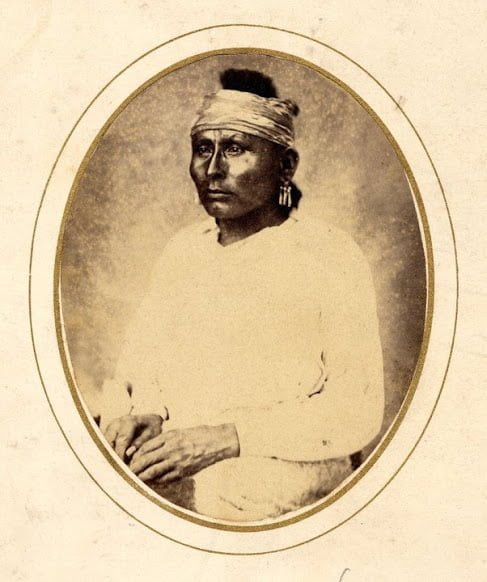The Osage tribe is theoretically separated into twenty-one fireplaces. These fireplaces were grouped into three divisions:
- The Seven Tsi-shu Fireplaces
- The Seven Hanka Fireplaces
- The Seven Osage Fireplaces (the Wa-sha-she Fireplaces)

Each fireplace is a gens, so the Osage tribe is composed of twenty-one gentes, or clans. When the two sides of the tribe were fixed – the War Side and the Peace Side – there were but fourteen gentes in the Nation. At that time the Osage camping circle, or tribal circle was adopted. Positions for the fourteen gentes were provided. At some period after the adoption of this camping circle the tribe was enlarged by the admission of the Seven Hanka fireplaces. It was not practicable to enlarge the camping-circle, for it had of necessity, to contain an even Hanka fireplaces. It was not practicable to enlarge the camping-circle, for it had of necessity, to contain an even number of fireplaces, that it should show an even balance of sideseach side an equal number of fireplaces. In making the adaptation of the tribe, as enlarged, to the old tribal circle, the seven Hanka gentes were counted as but five, and the seven Osage gentes were reckoned as only two.
In the tribal ceremonies it was the law that each fireplace should have a pipe, or be assigned a pipe, or to be in some way associated with or represented by a pipe. The Hanka brought in seven such pipes when it joined the tribe. The Wa-sha-she had seven of these pipesone for each of their fireplaces. For some reasonyet unexplainedthe Tsi-shu had no pipes of this nature. To remedy this defect, the Wa-sha-she, or Osage, gave their seventh ceremonial pipe to the Tsi-shu, with authority to the Tsi-shu to make for themselves seven pipes from it. The Wa-sha-she have now but six ceremonial pipes, though the ceremonies for the seventh are still retained.
The fourteen gentes represented in the Osage tribal circle, with their subgentes, are as follows:
- Elder Tsi-shu, or Tsi-shu-wearing-a-tail (of hair) -on-the-head
- Sun and Comet People
- Wolf People
- Buffalo-bull face
- (Not known.)
- Hide-with-the-hair-on
- Sun Carriers. Carry-the-sun (or Buffalo hides) -on-their-backs
- Sun People
- Swan People
- Tsi-shu Peacemaker, or Villagemaker, or Giver of Life
- Touches-no-blood, or Red Eagle
- Bald Eagle, or Sycamore People. The principal gens of the left side of the tribal circle
- Night People, or Tsi-shu-at-the-end
- Night People proper
- Black Bear People
- Buffalo Bul
- Buffalo Bull
- Reddish Buffalo. (Corresponds to the Yuqe of the Kanss.)
- Thunder Being, or Camp-last, or Upper World People, or Mysterious Male being (Subgentes not ascertained.)
- Elder Osage, or Wa-sha-she Wa-nun. This gens embraces six of the seven Wa-sha-she or Osage Fireplaces, as follows:
- White Osage
- Turtle Carriers
- Tall Flags
- Deer Lights, or Deer People
- Fish People
- Turtle People. (Turtle-with-serrated-crest-along-the-shell. Possibly a mythical water monster.)
- Real Eagle People, or Hanka-apart-from-the-rest. The War Eagle gens. One of the original Hanka Fireplaces. The guards, policemen, or soldiers for the right side of the tribal circle are taken from the eight and ninth gentes.
- Ponka Peacemaker. This is the principal gens on the right side of the tribe circle. It was one of the original seven Osage Fireplaces
- Pond Lily
- Dark Buffalo. Or, as some say
- Flags
- Warrior-come-hither-after-touching-the-foe
- Red Cedar
- White Eagle People, or Hanka-having-wings. These Subgentes were two of the original seven Hanka Fireplaces:
- Elder White Eagle People
- Those-wearing-four-locks-of-hair.
- Having Black Bears
- Wearing-a-tail-of-hair-on-the-head
- Black Bear
- (Meaning not ascertained.)
- Wearing-four-locks-of-hair
- Swan
- 2. Dried Pond Lily
- Wearing-a-tail-of-hair-on-the-head
- 13. Elk, One of the seven Hanka Fireplaces
- 14. Kansa, or Holds-a-firebrand-to-the-sacred-pipes-in-order-to-light-them, Or, South Wind People, Or, Wind People, Or, Fire People
Each of the divisions A and B of the twelfth gens were originally a Fireplace of the Hanka.
There are four divisions of the Osages which have not yet been identified, the:
- Beaver People
- Crane People
- Owl People
- Earth People
Osage Religion

The religious beliefs of the Osages are similar to those of the Kansas and other Siouan tribes. The term Wakanda had almost the same meaning. There were seven great Wakandas Darkness, the Upper World, the Ground, the Thunder-being, the Sun, the Moon, the Morning Star. The Upper World was perhaps the greatest of the Wakandas. In some of the tribes it was the supreme Wakanda. There was no set form of worship of Wakanda. Every one thought Wakanda dwelt in some secret place. It was believed that the Wakanda, or some Wakanda was ever present to hear any petition or prayer for help. There were many forms of propitiation, or these may have been sometimes in the nature of invocations, such as the elevation and lowering of the arms, the presentation of the mouth-piece of the pipe, the emission of the smoke, the burning of cedar needles in the sweat house, the application of the major terms of kinship, ceremonial waiting, sacrifice and offerings, and the cutting of the body with knives.
The Osages call the Sun the mysterious one of day, and pray to him as grandfather. Prayer was always made toward the sun without regard to its position in the heavens. Here is a prayer.
Ho, Mysterious Power, you who are the Sun! Here is tobacco! I wish to follow your course. Grant that it may be so! Cause me to meet whatever is good (i. e., for my advantage) and to give a wide berth to anything that may be to my injury or disadvantage. Throughout this island (the world) you regulate everything that moves, including human beings. When you decide for one that his last day on earth has come, it is so. It can not be delayed. Therefore, O Mysterious Power, I ask a favor of you.
The Pleiades, the constellation of the Three Deer (Belt of Orion), the Morning Star, the Small Star, the Bowl of the Dipper, are all Wakandas, and they are addressed as “Grandfather.” In the Osage traditions, cedar symbolizes the tree of life. When a woman is initiated into the secret society of the Osages, the officiating man of her gens gives her four sips of water, symbolizing, so they say, the river flowing by the tree of life, and then he rubs her from head to foot with cedar needles, three times in front, three times on her back, and three times on each side, twelve times in all, pronouncing the sacred name of Wakanda as he makes each pass.
These instances are given to aid in the formation of a proper conception of the Wakanda as regarded by the Osages. In the Siouan tongue Wakandagi, as a noun, means a subterranean or water monster, a large horned reptile mentioned in the myths, and still supposed to dwell beneath the bluffs along the Missouri river. 1
Osage History
Much concerning the early history of the Osages has already been told in the account of Pike’s expedition and the history of the Kansas. They called themselves Wa-zha-zhe. This name the French Traders corrupted to the present Osage. In historic times the tribe was divided into three bands:
- Pahatsi, or Great Osages
- Utsehta, or Little Osages
- Santsnkhdhi, or the Arkansas Band.

There are different accounts as to how the tribe became separated into the two principal bands Great and Little Osages. Some insist that the division occurred in primal times. The Osages then dwelt about a great mountain, an immense mound, or a big hill. One part of the tribe lived on the mountain, the remainder on the plain. Those on the elevation came to be called there the Great Osages, and those living in the plain were the Little Osages. It has been suggested that the names represented a social difference or some tribal distinction long forgotten by even the Osages themselves. In all probability there is no foundation for any of these explanations. Isaac McCoy, in his History of Baptist Indian Missions says the division was the result of some fault of the early traders among them. There were then two towns on the Missouri belonging to the Osages. The one above became known as the Upper town, and the people dwelling there as the Upper People. In like manner, those at the town below were the Lower People. Each town had its chief and separate local government. The white people, having an imperfect knowledge of the language and conditions of the Osages, supposed that the names of the towns signified that all the tall or large people of the tribe lived at the Upper settlement, and that all the short or small people lived in the Lower settlement. There came to be told among the white people in pioneer times the story that the tribe had made an arrangement whereby all the tall people should be in one band and live in one town, while all the short men should dwell together in another town. Intelligent travelers never did mention that there was any difference in the stature of the Great and Little Osages. The terms may not have originated as McCoy says. They may have grown out of the relative size of their two towns in early times. Or in some other way not now remembered by the Osages themselves.
The origin of the Arkansas Band is known. About 1796 Manuel Lisa secured from the then government of Louisiana a monopoly to trade with all the Indians on the waters of the Missouri River. This, of course, included the Osages. Previous to that time the trade went to traders in competition, among these the Chouteaus. The monopoly of Lisa cast out the Chouteaus. Pierre Chouteau had at one time enjoyed a monopoly of the Osage trade. When he was superseded as agent of the tribe by Lisa, he sought some means of continuing his profitable business relations with the tribe. He determined to divide it, and to settle a part of it beyond the jurisdiction of Lisa. He induced the best hunters of the tribe to go with him to the Lower Verdigris. This stream is a branch of the Arkansas River, none of the waters of which were included in the grant to Lisa. Chouteau took only young men and their families, and they were from both the Great and Little Osages. They built towns near the mouth of the Verdigris River. Later they went to the Arkansas and had towns both above and below the mouth of the Verdigris. By the French they were known as Osage des Chenes (Osage of the Oaks). Des Chenes was corrupted into a number of terms, of which Chancers was one. The date of the formation of this band and its migration to the Verdigris is given as about 1803 by Lewis and Clark, Dr. Sibley and Mr. Dunbar, in their report published in 1806. They say nearly one-half the Osage nation followed Chouteau. Also, that The Little Osage formerly resided on the S. W. side of the Missouri, near the mouth of the Grand River; but being reduced by continual warfare with their neighbors, were compelled to seek the protection of the Great Osage, near whom they now reside. Their village was set up, on their return, where Pike found it when he ascended the Osage on his way to the Pawnee country.
Fort Osage, afterwards Fort Clark, where Sibley, Missouri, now is, was established in

October, 1808, as a protection to the Osage Indians, as cited in the preamble of the treaty of November 10, 1808, with the tribe. But the Government dealt unfairly in that matter. The fort and trading post had been promised in 1804 and in 1806. In less than a month after it was built, Pierre Chouteau appeared at the fort with the treaty of the 10th of November already written out. It had been prepared without any consultation with a single Osage. Chouteau had the treaty read and explained to the assembled chiefs and warriors. Then he announced that those who signed it would be considered friends of the United States and treated accordingly, and those who refused to sign would be regarded as enemies. The chief, White Hair, protested, but acknowledged the helplessness of the Indians. He signed the treaty, and fear of being counted enemies of the United States caused all present to sign. This treaty exacted a large tract of land as the price of building Fort Osage. The land was thus described in the treaty:
Beginning at Fort Clark (Fort Osage) on the Missouri, five miles above Fire Prairie, and running thence a due south course to the river Arkansaw and down the same to the Mississippi.
All the land east of that line was ceded to the United States. There was much dissatisfaction on the part of the Osages, and they never did understand why the concession was enacted.
The Osages began to move to the westward from their homes in what is now Vernon County, Mo., in 1815. Some of them may have gone before that date. They fixed their new towns on the Neosho. In the year 1817 the Cherokees destroyed the Osage town on the Verdigris. They also destroyed the crops and carried off as prisoners some fifty old people and children. The warriors were absent at the time, but they took up the hatchet upon their return. The Delawares assisted the Cherokees, and the war continued until 1822.
In 1820 the Great Osages had one village on the Neosho, and the Little Osages had three on the same stream. Of these Colonel Sibley reported in that year:
- The Great Osages of the Osage River
They live in one village on the Osage river 78 miles (measured) due south of Fort Osage. They hunt over a very great extent of country, comprising the Osage, Gasconade, and Neeozho rivers and their numerous branches. They also hunt on the heads of the St. Francois and White rivers, and on the Arkansas. I rate them at about 1,200 souls, 350 of whom are warriors or hunters, 50 or 60 are superannuated, and the rest are women and children.
- The Great Osages of the Neeozho
They have one village on the Neeozho river, about 130 or 140 miles southwest of Ft. Osage. They hunt pretty much in common with the tribe of the Osage river, from whom they separated six or eight year ago. This village contains about four hundred souls, of whom about 100 are warriors, and hunters, some 10 or 15 are aged persons, and the rest are women and children. Papuisea, or White Hair, is principal chief.
- The Little Osage
Three villages on the Necozho river, about 130 or 140 miles southeast of this place (Ft. Osage). This tribe, comprising all three villages and comprehending about twenty families of Missouries that are intermarried with them, I rate about 1,000 souls, about 300 of whom are hunters and warriors, twenty or thirty superannuated and the rest are women and children. They hunt pretty much in common with the other tribes of Osages mentioned, and frequently on the headwaters of the Kansas, some of the branches of which interlock with those of the Neeozho. Nechoumani, or Walking Rain, principal chief. [Called Nezuma, or Rain that Walks by Pike and Wilkinson.]
Of the Chaneers, or Arkansas tribes of Osages, I say nothing, because they do not resort here to trade. I have always rated that tribe at about an equal half of all the Osages. They hunt chiefly on the Arkansas and White rivers, and their waters.

From this time until after the Civil War the Osages lived principally in Kansas. One post in Kansas resulted from trade with the Osages while they lived yet in Missouri. The Missouri Fur Company had a trading post near their towns before 1812. It was abandoned that year. When other posts were established is not now known, but the founders of Harmony Mission, who came out in 1821, found several traders seated in the country along the Osage River. One was where Papinville, Vernon County, Missouri, was afterwards laid out. Another was at the Collen Ford, on the Osage. The founders of these posts are not now known. About 1831 Michael Gireau and Melicourt Papin had stores at Collin Ford. Papin had another at the site of Papinville. There were half a dozen French families at Gireau’s store, as well as some half-breed families. They were probably hunters and petty traders. In 1839 Gireau moved his store and established himself further up the Marais des Cygnes, in what is now Linn County, Kansas. The place was later known as Trading Post, a name it still bears. About 1842 this post was sold to one of the Chouteaus, probably Gabriel Chouteau, and it was then called Chouteau’s Trading Post. It bore a part in the Territorial history of Kansas.
Citations:
- All that is said in this article, as well as much in the article on the Kansa, when not otherwise indicated, is taken from the writings of J. Owen Dorsey, in the Reports of the Bureau of Ethnology. He is the best authority, and often the only authority.[↩]


